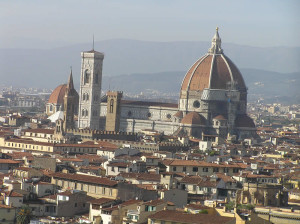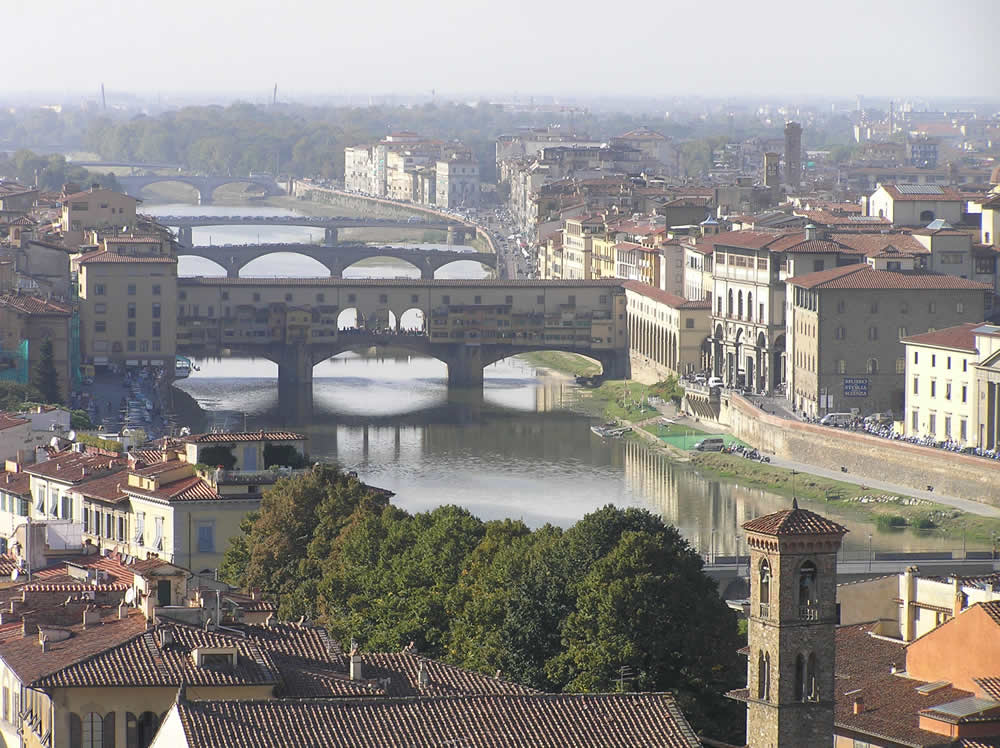Questo articolo è disponibile anche in:
![]() Français
Français ![]() Deutsch
Deutsch ![]() Español
Español ![]() Italiano
Italiano
The city of Florence has a temperate Mediterranean climate, with hot, dry summers and cold, damp winters. The climate of Florence is influenced by its location in a valley at the foot of the Apennines to the north and surrounded by the hills of Chianti to the south.
Summers are very hot with average maximum temperatures of over 30 ° C and absolute maximum sometimes approaching 40 ° C. July and August are the hottest months, ill-adapted to a visit to the city because of the great heat. This is also due to poor ventilation caused by the sheltered position of the city. The position of Florence, in a valley set among the hills makes it usually one of the hottest cities in Italy.
Autumn is the wettest period of the year, the wettest months are November and December. Winter is cold and often rainy, the temperature can drop below freezing, but the snow is a rare event in the city, on average some dim snow can fall 1 or 2 times a year. Florence has an average of 41 days of frost per year, that is, days with average minimum temperature below zero.

RAINFALL
Rainfall is concentrated mainly in the fall and to a lesser extent in the spring. The average annual rainfall is between 800 mm and 900 mm, the rainiest month is November followed by December and October. The driest month is July. Florence has an average of 88 days of rain a year, they vary between 9 rainy days of rain in April and November and 3 days of rain in July.
The average maximum temperatures vary between 31 ° C in July and August and 11 ° C in December and January. The average minimum temperatures ranging between 17 ° C in July and August and 2 ° C in January.
WHEN TO GO TO FLORENCE
Consider that every period of the year is indicated to visit a beautiful city like Florence. Winter can sometimes be cold, but sunny days, which are not rare, allow seeing the city in a time when tourists are few and the museums are not too crowded.
Autumn is the wettest period, but also in the fall you can enjoy the beauty of the city, in fact often especially in October the weather is very mild. Spring is probably the best time to visit Florence, the weather is pleasant, the days are long and the city with the green hills that surround it appears in his best moment.
Summer has beautiful sunny days but it is often very hot and muggy. The end of summer, especially the month of September is another great time to visit the city. In conclusion, the best time for a trip to Florence are the months of spring – from March to June – and the month of September.
[divider]
[divider]
CLIMATE OF FLORENCE: CLIMATE DATA
[divider]
| FLORENCE PERETOLA (40 meters) | ||||
| Month | Average high (°C) | Average low (°C) | Precip. (mm) | Precip. days |
| January | 2,0 | 10,9 | 60,5 | 8,3 |
| February | 2,5 | 12,5 | 63,7 | 7,1 |
| March | 4,9 | 15,7 | 63,5 | 7,5 |
| April | 7,5 | 18,5 | 86,4 | 9,7 |
| May | 11,6 | 23,7 | 70,0 | 8,4 |
| June | 15,0 | 27,7 | 57,1 | 6,3 |
| July | 17,7 | 31,4 | 36,7 | 3,5 |
| August | 17,7 | 31,5 | 56,0 | 5,4 |
| September | 14,4 | 26,7 | 79,6 | 6,2 |
| October | 10,1 | 20,9 | 104,2 | 8,5 |
| November | 5,1 | 14,7 | 113,6 | 9,0 |
| December | 2,6 | 11,1 | 81,3 | 8,3 |
| YEAR | 9,3 | 20,4 | 872,6 | 88,2 |
[divider]
Questo articolo è disponibile anche in:
![]() Français
Français ![]() Deutsch
Deutsch ![]() Español
Español ![]() Italiano
Italiano

